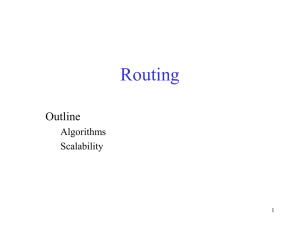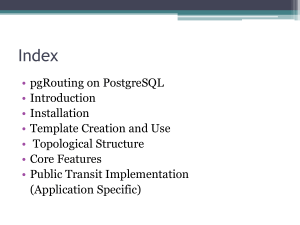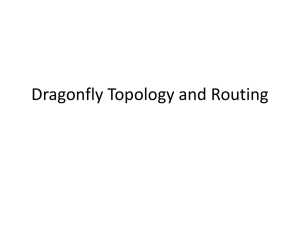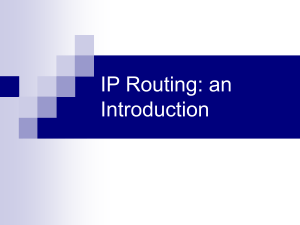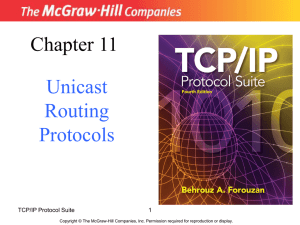Distance Vector Routing
advertisement
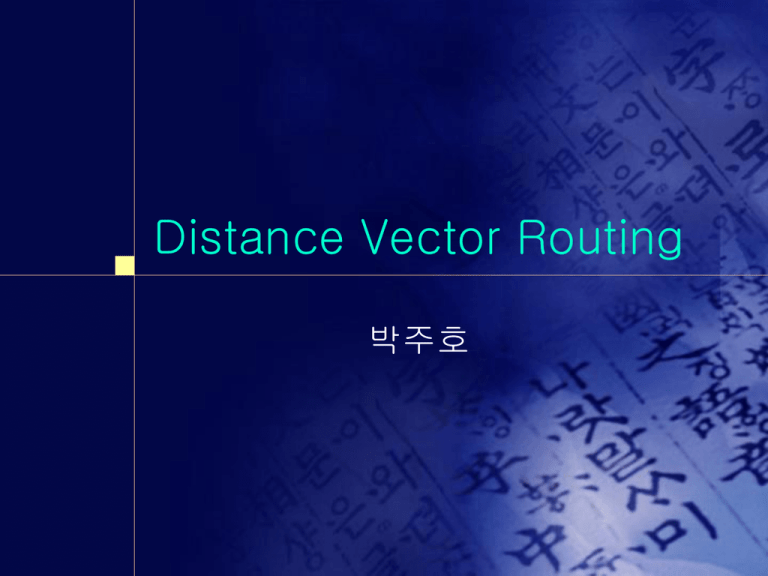
Distance Vector Routing 박주호 Introduction. Modern computer Network generally use Dynamic routing algorithms rather than The static one. Two dynamic algorithm – Distance vector routing – Link state routing juhpark@cs.chonbuk.ac.kr 2 Distance vector routing This algorithms operate by – Having each router maintain a table – The table(i.e vector) give the best known distance to each destination and which line to use to get there. Updated by exchanging information with the neighbors. juhpark@cs.chonbuk.ac.kr 3 History Sometimes called by other names… Distributed Bellman-Ford routing algorithm(1957) Ford-Fulkerson algorithm(1962) It was original ARPANET routing algorithm And was used – In the Internet(RIP) – In early versions of DECnet and Novell’s IPX AppleTalk and Cisco routers use improved distributed vector protocols. juhpark@cs.chonbuk.ac.kr 4 The Routing table Each router maintains a routing table – Contain one entry. – Two part of one entry The preferred outgoing line An estimate of the time or distance distance 20 10 Line A B The router is assumed to know the “distance” to each of its neighbors. juhpark@cs.chonbuk.ac.kr 5 The Metric of distance Number of hops – The distance is just one hop Time delay in milliseconds – The router can measure… – Using special ECHO packets(timestamps) Total number of packets queued along the path – The router simply examines each queue juhpark@cs.chonbuk.ac.kr 6 Algorithm A E B C F G D H To A I H K A 0 24 20 21 8 A B 12 36 31 28 20 A C 25 18 19 36 28 I D 40 27 8 24 20 H E 14 7 17 I 30 I 18 H 12 H 10 I F G H I J K L (a) Receive table Distances to (b) from each neighbors neighbor New estimated dealy from J Line I 30 JA =228 23 20 19 40 JA = 68 31 18 31 17 AB 20 = 12 0 19 JB21= JA+AB 20 0 14 =22 J 9 11 7 10 0 - K 24 22 22 0 6 K L 29 33 9 9 15 K JA JI JH JK delay delay delay delay is is is is 8 10 12 6 Vectors received from J’s four neighbors juhpark@cs.chonbuk.ac.kr New routing table for J 7 The Count-to-Infinity Problem Distance vector routing works in theory – A serious drawback in practice Reacts rapidly to good news, But leisurely to bad news. A B C D E 1 1 2 1 2 1 2 3 3 4 A Initially After 1 exchange After 2 exchange After 3 exchange After 4 exchange B C 1 3 3 5 5 7 7 2 2 4 4 6 6 8 3 3 3 5 5 7 7 4 4 4 4 6 6 8 juhpark@cs.chonbuk.ac.kr D E Initially After 1 exchange After 2 exchange After 3 exchange After 4 exchange After 5 exchange After 6 exchange 8 In case good news. – If longest path of subnet is N hops, – Everyone will know good news. In case bad news. – Infinity… – Set infinity to the longest path + 1. – If metric is time delay, no well-defined upper bound. – There is a tradeoff… juhpark@cs.chonbuk.ac.kr 9 The Split Horizon Hack Many ad hoc solutions to the problem have been proposed… – But, complicate , useless … One of them will be described(why fail?) The Split Horizon Hack algorithm A B C D E 1 2 3 4 Initially 2 3 4 After 1 exchange 3 4 After 2 exchange 4 After 3 exchange After 4 exchange juhpark@cs.chonbuk.ac.kr 10 A B C Router D Fig. 5-12. An example where split horizon fails. juhpark@cs.chonbuk.ac.kr 11




